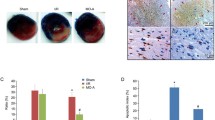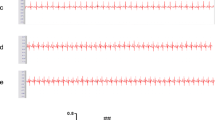Abstract
Apigenin is a traditional Chinese medicine found in many plants that plays critical roles in several diseases, including cardiovascular diseases. We investigated the protective effect of apigenin against ischemia/hypoxia (I/H)-induced myocardium injury in vitro and explored the potential molecular mechanisms. Together with the flow cytometry results, our results indicated that apigenin attenuated the pyroptosis and apoptosis of myoblastic H9c2 cells that were induced by I/H injury. Furthermore, the pro-inflammatory cytokines (interleukin 18, IL-18, and IL-1β) were investigated for the roles of apigenin in I/H-induced myocardium injury. It was observed that increases in IL-1β and IL-18 levels were significantly reduced by apigenin treatment of I/H-induced H9C2 cells. The results demonstrated that apigenin protected H9c2 cells against I/H-induced myocardium injury. The protective effects were most likely related to the reduction of pyroptosis, apoptosis, and pro-inflammatory cytokines.




Similar content being viewed by others
References
Bergsbaken T, Fink SL, Cookson BT (2009) Pyroptosis: host cell death and inflammation. Nat Rev Microbiol 7(2):99–109
Boshra V, Atwa A (2016) Effect of cerebrolysin on oxidative stress-induced apoptosis in an experimental rat model of myocardial ischemia. Physiol Int 103(3):310–320
Bryan NB, Dorfleutner A, Rojanasakul Y, Stehlik C (2009) Activation of inflammasomes requires intracellular redistribution of the apoptotic speck-like protein containing a caspase recruitment domain. J Immunol 182(5):3173–3182
Buwa CC, Mahajan UB, Patil CR, Goyal SN (2016) Apigenin attenuates β-receptor-stimulated myocardial injury via safeguarding cardiac functions and escalation of antioxidant defence system. Cardiovasc Toxicol 16(3):286–297
Chen C, He H, Luo Y, Zhou M, He M (2015) Involvement of Bcl-2 signal pathway in the protective effects of Apigenin on anoxia/reoxygenation-induced myocardium injury. J Cardiovasc Pharmacol 67(2):152
Chen J, Hsieh AF, Dharmarajan K, Masoudi FA, Krumholz HM (2013) National trends in heart failure hospitalization after acute myocardial infarction for Medicare beneficiaries: 1998–2010. Circulation 128(24):2577–2584
de Zoete MR, Palm NW, Zhu S, Flavell RA (2014) Inflammasomes. Cold Spring Harb Perspect Biol 6(12):a016287
Elmore S (2007) Apoptosis: a review of programmed cell death. Toxicol Pathol 35(4):495–516
Galluzzi L, Buqué A, Kepp O, Zitvogel L, Kroemer G (2017) Immunogenic cell death in cancer and infectious disease. Nat Rev Immunol 17(2):97–111
Ghayur T, Banerjee S, Hugunin M et al (1997) Caspase-1 processes IFN-gamma-inducing factor and regulates LPS-induced IFN-gamma production. Nature 386(6625):619–623
Green DR, Llambi F (2015) Cell death signaling. Cold Spring Harb Perspect Biol 7(12):a006080
Gu Y, Kuida K, Tsutsui H et al (1997) Activation of interferon-gamma inducing factor mediated by interleukin-1beta converting enzyme. Science 275(5297):206–209
He Y, Hara H, Nunez G (2016) Mechanism and regulation of NLRP3 inflammasome activation. Trends Biochem Sci 41(12):1012–1021
Krajewska M, Mai JK, Zapata JM, Ashwell KW, Schendel SL, Reed JC, Krajewski S (2002) Dynamics of expression of apoptosis-regulatory proteins bid, Bcl-2, Bcl-X, Bax and Bak during development of murine nervous system. Cell Death Differ 9(2):145–157
Lamkanfi M, Dixit VM (2014) Mechanisms and functions of inflammasomes. Cell 157(5):1013–1022
Leyva-Lopez N, Gutierrez-Grijalva EP, Ambriz-Perez DL, Heredia JB (2016) Flavonoids as cytokine modulators: a possible therapy for inflammation-related diseases. Int J Mol Sci 17(6):921
Li F, Lang F, Zhang H et al (2017) Apigenin alleviates endotoxin-induced myocardial toxicity by modulating inflammation, oxidative stress, and autophagy. Oxidative Med Cell Longev 2017:1-10
Liu Y, Lian K, Zhang L, Wang R, Yi F, Gao C, Xin C, Zhu D, Li Y, Yan W, Xiong L, Gao E, Wang H, Tao L (2014) TXNIP mediates NLRP3 inflammasome activation in cardiac microvascular endothelial cells as a novel mechanism in myocardial ischemia/reperfusion injury. Basic Res Cardiol 109(5):415
Ma L, Chuang CC, Weng W et al (2016) Paeonol protects rat heart by improving regional blood perfusion during no-reflow. Front Physiol 7:298
Man SM, Karki R, Kanneganti TD (2017) Molecular mechanisms and functions of pyroptosis, inflammatory caspases and inflammasomes in infectious diseases. Immunol Rev 277(1):61–75
Martinon F (2010) Signaling by ROS drives inflammasome activation. Eur J Immunol 40(3):616–619
Mezzaroma E, Toldo S, Farkas D et al (2011) The inflammasome promotes adverse cardiac remodeling following acute myocardial infarction in the mouse. Proc Natl Acad Sci U S A 108(49):19725–19730
Pomerantz BJ, Reznikov LL, Harken AH, Dinarello CA (2001) Inhibition of caspase 1 reduces human myocardial ischemic dysfunction via inhibition of IL-18 and IL-1beta. Proc Natl Acad Sci U S A 98(5):2871–2876
Rodriguez-Mateos A, Vauzour D, Krueger CG, Shanmuganayagam D, Reed J, Calani L, Mena P, del Rio D, Crozier A (2014) Bioavailability, bioactivity and impact on health of dietary flavonoids and related compounds: an update. Arch Toxicol 88(10):1803–1853
Rogers C, Fernandes-Alnemri T, Mayes L, Alnemri D, Cingolani G, Alnemri ES (2017) Cleavage of DFNA5 by caspase-3 during apoptosis mediates progression to secondary necrotic/pyroptotic cell death. Nat Commun 8:14128
Sadoul R (1998) Bcl-2 family members in the development and degenerative pathologies of the nervous system. Cell Death Differ 5(10):805–815
Sivaraman V, Yellon DM (2014) Pharmacologic therapy that simulates conditioning for cardiac ischemic/reperfusion injury. J Cardiovasc Pharmacol Ther 19(1):83–96
Sung B, Chung HY, Kim ND (2016) Role of apigenin in cancer prevention via the induction of apoptosis and autophagy. J Cancer Prev 21(4):216–226
Teringova E, Tousek P (2017) Apoptosis in ischemic heart disease. J Transl Med 15(1):87
Venigalla M, Gyengesi E, Munch G (2015) Curcumin and apigenin - novel and promising therapeutics against chronic neuroinflammation in Alzheimer’s disease. Neural Regen Res 10(8):1181–1185
Wang Y, Gao W, Shi X et al (2017) Chemotherapy drugs induce pyroptosis through caspase-3 cleavage of a gasdermin. Nature 547(7661):99–103
Wang Z, Yu J, Wu J, Qi F, Wang H, Wang Z, Xu Z (2016) Scutellarin protects cardiomyocyte ischemia-reperfusion injury by reducing apoptosis and oxidative stress. Life Sci 157:200–207
Wree A, Eguchi A, McGeough MD, Pena CA, Johnson CD, Canbay A, Hoffman HM, Feldstein AE (2014) NLRP3 inflammasome activation results in hepatocyte pyroptosis, liver inflammation, and fibrosis in mice. Hepatology. 59(3):898–910
Yang X, Yang J, Hu J, Li X, Zhang X, Li Z (2015) Apigenin attenuates myocardial ischemia/reperfusion injury via the inactivation of p38 mitogen activated protein kinase. Mol Med Rep 12(5):6873–6878
Yao HM, Jia YP, Xue Z, Guo M, Lyu JY (2017) Effects of apigenin on lipopolysaccharide induced proliferation of rat aortic vascular smooth muscle cells. Chin J Cardiol. 45(4):323–328
Ye B, Chen X, Dai S et al (2019) Emodin alleviates myocardial ischemia/reperfusion injury by inhibiting gasdermin D-mediated pyroptosis in cardiomyocytes. Drug Des Devel Ther 13:975–990
Zhang S, Liu X, Sun C, Yang J, Wang L, Liu J, Gong L, Jing Y (2016) Apigenin attenuates experimental autoimmune myocarditis by modulating Th1/Th2 cytokine balance in mice. Inflammation. 39(2):678–686
Zhao Y, Shi J, Shao F (2018) Inflammatory caspases: activation and cleavage of gasdermin-D in vitro and during pyroptosis. In: Innate Immune Activation. Springer, pp 131–148
Zheng Y, Niu G, Zhang H, Lu W, Liu Z (2019) Estrogen replacement therapy is not a recommended therapy for postmenopausal women with coronary heart disease: a meta-analysis. Clin Exp Obstet Gynecol 46(2):219–226
Zhu ZY, Gao T, Huang Y, Xue J, Xie ML (2016) Apigenin ameliorates hypertension-induced cardiac hypertrophy and down-regulates cardiac hypoxia inducible factor-l alpha in rats. Food Funct 7(4):1992–1998
Funding
This study was funded by the Second Hospital of Army Medical University.
Author information
Authors and Affiliations
Contributions
WL and YBX conceived and designed the experiments. WL and LC performed the experiments. WL analyzed the data. WL and YBX wrote the paper.
Corresponding author
Ethics declarations
Conflict of interest
The authors declare that they have no conflict of interest.
Ethical approval
This study was performed following institutional and national guidelines.
Additional information
Editor: Tetsuji Okamoto
Rights and permissions
About this article
Cite this article
Li, W., Chen, L. & Xiao, Y. Apigenin protects against ischemia-/hypoxia-induced myocardial injury by mediating pyroptosis and apoptosis. In Vitro Cell.Dev.Biol.-Animal 56, 307–312 (2020). https://doi.org/10.1007/s11626-020-00434-9
Received:
Accepted:
Published:
Issue Date:
DOI: https://doi.org/10.1007/s11626-020-00434-9




